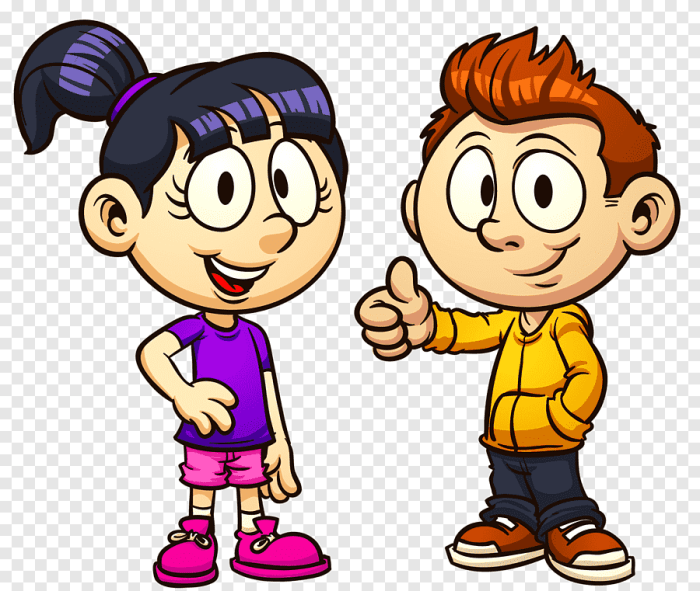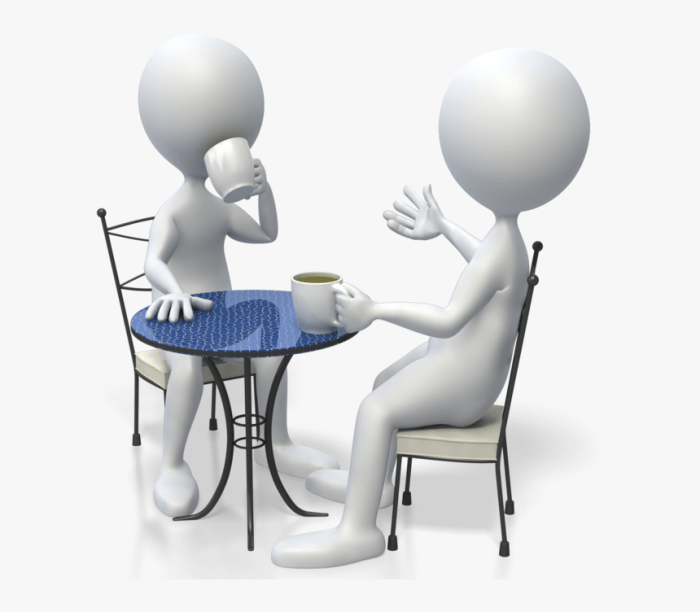Defining “Easy” Animated Drawings

Animated drawing of two people easy – Creating easy animated drawings of two people hinges on simplifying both the character designs and their movements. The goal is to achieve a visually appealing animation without getting bogged down in excessive detail or complex animation techniques, making it accessible to beginners. This involves strategic choices regarding linework, character proportions, and posing.Easy animation prioritizes clear, concise lines and avoids intricate details.
Think clean silhouettes and simple shapes rather than highly detailed features. Movement should be straightforward and easily understood, focusing on key poses and minimizing in-betweens where possible. The overall aesthetic should be charming and expressive, even with its simplicity.
Mastering an animated drawing of two people, even a simple one, requires understanding basic shapes and movement. For inspiration, consider the unique attire and poses found in a highland scots drawing easy tutorial; the kilts and tartans offer interesting folds and textures to study. Applying these principles back to your animated characters will add depth and realism to even the simplest sketches.
Simplified Body Shapes and Poses, Animated drawing of two people easy
Effective simplification of human figures for animation often involves using basic geometric shapes as a foundation. Instead of meticulously drawing every muscle and bone, beginners should focus on building characters from circles, ovals, rectangles, and cylinders. A head might be a circle, the torso an oval, and limbs simplified as cylinders or slightly curved rectangles. Poses should be exaggerated yet easily readable, emphasizing clear actions rather than subtle nuances.
For instance, instead of a nuanced walking pose, a simple alternating leg movement is sufficient. Similarly, a joyful expression can be conveyed through wide, simple eyes and a large, upward-curving mouth, avoiding the need for intricate facial muscles.
Techniques for Minimizing Detail While Maintaining Visual Appeal
Maintaining visual appeal while minimizing detail requires a focus on strategic simplification. Instead of detailed shading, consider using flat colors or simple gradients to define form. Line weight can be used effectively to create depth and emphasis; thicker lines for Artikels and thinner lines for details. Exaggerated features, such as large eyes or expressive hands, can add personality and compensate for the lack of intricate details.
Consider using limited color palettes to create a unified and visually appealing style. The use of simple background elements also contributes to the overall simplicity and avoids distracting from the main characters. For example, instead of a detailed background, a single solid color or a simple pattern can suffice.
Character Design for Simple Animation
Effective character design is paramount for simple animation. Simplicity allows for quicker animation and easier comprehension by the audience, but it shouldn’t compromise memorability or personality. The goal is to create distinct characters that are instantly recognizable and engaging, even with minimal detail.Character design for simple animation hinges on clear visual communication. Overly complex designs are difficult to animate consistently and can distract from the story.
By focusing on key features and limiting the color palette, animators can maintain visual clarity and speed up the production process. This approach also ensures the animation remains accessible to a broad audience.
Character Design Choices
We will design two characters: a playful, energetic girl named Pip and a calm, thoughtful boy named Leo. Their contrasting personalities will be reflected in their designs. Pip will have bright, expressive eyes and bouncy hair, while Leo will have a more subdued appearance with simple, neatly styled hair. Both will utilize a limited color palette to maintain simplicity.
Pip’s primary colors will be bright orange and yellow, while Leo’s will be blue and grey.
Clothing Design for Easy Animation
Simple clothing styles are crucial for efficient animation. Avoid intricate patterns, excessive details, or clothing items that are prone to complex movement. Pip will wear a simple orange jumpsuit with minimal seams and a single yellow stripe. This minimizes the number of individual parts that need to be animated. Leo will wear a blue shirt and grey pants; both garments will be solid colors without patterns or folds that would require extensive attention during the animation process.
This ensures smooth and consistent movement.
Character Descriptions
Pip is a whirlwind of energy. Her bright orange jumpsuit reflects her sunny disposition and her large, expressive eyes convey her constant enthusiasm. She is curious, adventurous, and always ready for a challenge. Leo, in contrast, is quiet and contemplative. His blue shirt and grey pants represent his calm demeanor.
He is thoughtful, observant, and possesses a gentle nature. Their relationship is one of playful companionship; Pip often encourages Leo to participate in her adventures, while Leo provides a calming presence amidst Pip’s exuberance. Their contrasting personalities create a dynamic duo, ideal for simple animation where clear characterization is vital.
Animating the Interaction: Animated Drawing Of Two People Easy

Animating a simple conversation between two easily drawn characters, focusing solely on head and hand movements, allows for a clear demonstration of fundamental animation principles without overwhelming complexity. This approach prioritizes conveying emotion and interaction through minimal yet impactful movement. The simplicity ensures the core concepts remain accessible to beginners while still producing a visually engaging result.Animating a simple conversation necessitates a clear understanding of timing, spacing, and the exaggeration of movement to emphasize emotion.
Subtle shifts in head position and hand gestures can effectively communicate a wide range of feelings and reactions. By limiting the scope to these key elements, the animator can focus on refining the quality of the movement rather than getting bogged down in complex body mechanics.
Animating a Single Frame of Interaction
The process of animating a single frame involves several key steps. First, a key pose is established, defining the starting point of the action. For example, Character A might be shown slightly tilting their head, indicating listening, while Character B has their hand gesturing towards a point off-screen. The next step involves identifying the in-betweens. These are the intermediary frames that smoothly transition between the key poses.
For instance, a series of in-between frames might subtly shift Character A’s head to a more upright position as they respond to Character B, while Character B’s hand gradually lowers. Finally, the entire frame is refined, paying attention to the flow of movement and the clarity of the action. Small adjustments to line weight or shading can significantly enhance the overall impact.
This meticulous approach to each frame, even a simple one, is crucial for a polished final product.
Creating Looping Animations
Looping animations are ideal for repetitive actions like breathing, blinking, or subtle nervous movements. To create a seamless loop, the animator needs to ensure that the final frame smoothly transitions back to the starting frame. This often involves subtle adjustments to the last frame to match the first. For example, a character’s breathing animation might involve a gradual expansion and contraction of the chest.
The final frame of the contraction should perfectly mirror the starting frame of the expansion, allowing for a continuous loop without any jarring transitions. This technique can add a layer of realism and personality to the characters without requiring extensive animation. A well-executed loop can enhance the overall feeling of life and natural movement in the animation.
Illustrative Examples

Simple animation thrives on clarity and impactful visual storytelling. Effective examples demonstrate how minimal design choices can create engaging narratives. The following illustrations showcase techniques for achieving this in a playful and easily reproducible manner.Simple Line Drawing of Two People in a Playful Pose
Simple Line Drawing Example
Imagine a line drawing of two stick figures. One, slightly taller, is leaning back, laughing uproariously, depicted by a series of exaggerated, upward-curving lines suggesting the movement of their body. Their arms are raised, again using simple, curved lines to indicate joyous abandon. The shorter figure, drawn with similarly basic lines, is playfully pushing the taller figure, their lines showing a slight forward lean and outstretched arm.
The lines used are predominantly thin, varying only slightly in thickness to emphasize certain movements. The thin lines keep the style clean and uncluttered, focusing the viewer’s attention on the pose and the implied interaction. Thicker lines might have been used to denote a stronger emphasis on a specific part of the body, like the push in the shorter figure’s arm, but in this instance, the simplicity of thin lines across the board enhances the playful feel.
Example Scene with Character Interaction
The scene is set against a bright yellow background, representing a sunny day. Two characters, a cat and a mouse, are depicted. The cat, a simple, rounded shape with triangular ears and a tail, is sitting calmly, its eyes half-closed, colored a gentle orange. The mouse, a smaller, gray shape with large, round ears, is cautiously approaching the cat, its body slightly tilted, suggesting a wary yet curious approach.
The colors are deliberately limited: the bright yellow background contrasts with the warm orange of the cat and the cool gray of the mouse. This simple color palette enhances the overall clarity and avoids visual clutter. The composition places the cat centrally, drawing the viewer’s eye, while the mouse is offset, creating a sense of anticipation and movement.
The background’s simplicity focuses attention on the interaction between the two characters.
Simple Walk Cycle Example
Let’s focus on the cat’s walk cycle. The key poses are: (1) Both feet together, body upright. (2) Right foot forward, body slightly leaning forward. (3) Left foot forward, right foot slightly behind, body in a slight mid-stride lean. (4) Both feet together again, body recovering to upright position.
The timing is crucial; each pose holds for approximately one frame, then transitions smoothly to the next. The repetition of these four poses creates the illusion of walking. The simplicity of the design allows for the clear observation of the cycle’s mechanics. The key poses are exaggerated slightly to enhance the animation’s impact, ensuring that the walk is both recognizable and visually engaging.
Quick FAQs
What software is best for this type of animation?
Many programs work, from free options like OpenToonz to more advanced paid software like Adobe Animate. The choice depends on your skill level and budget.
How long does it take to create a simple animation like this?
The time varies greatly depending on experience and complexity, but a simple animation could be completed in a few hours to a few days.
What are some good resources for learning more about animation?
Numerous online tutorials, courses, and communities offer valuable resources for learning animation techniques and principles. YouTube channels and online animation forums are excellent starting points.
Can I animate without drawing skills?
While drawing skills are helpful, simplifying the character design and using readily available assets can allow individuals with limited drawing skills to create animations.

